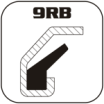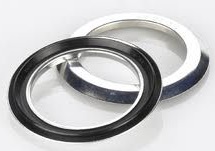

The RB and 9RB are axial seals consisting of 2 sections, one coated metal ring and one mould vulcanised elastomer sealing element.
The metal ring protects the elastomer seal against damage, serves as a stand and support for the elastomer seal and simultaneously acts as a flinger. The elastomer seal is not firmly bonded to but stretched over the metal ring and is additionally held by the axial flange.
With the 9RB the metal ring is extended in an axial direction on the outer sheath. Additional labyrinth sealing is created in combination with the circulating groove in the sliding surface.
Description
Product group: Axial seal
Profil-Nr.
RB = standard
9RB = extended metal ring
Seal material: NBR 70
Colour: black
Seal material: FKM 70
Colour: brown
Metallring: steel 1.0204 (SAE 1008) covered on demand
Metallring: stainless spring steel 1.4301 (SAE 304)
Area of application
RB axial seals are mainly used in combination with rotary shaft seals. They are applied as modular sealing elements affixed in series to seal against dirt, dust, grease and water spray from the outside. RB axial seals have been successfully used in drive technology and mechanical engineering for many years, e.g. in electric engines, transmissions, pumps, power saws, prop shafts, wheel hubs and axles, agricultural machinery, construction machinery, machine tools, roller bearing housings and washing machines.
Function
The RB axial seal fits tightly on the shaft (press fit) and must be installed at a precisely defined distance from the metal sliding surface to guarantee the defined axial prestress of the elastomer sealing element.
In rotation, the sealing lip rubs axially against the metal sliding surface at the contact pressure resulting from the selected prestress. The required sealing function is thus achieved. The total axial contact pressure results from the prestress in the installation housing, the geometry of the sealing lip as well as the elasticity and tensile properties of the elastomer.
The RB axial seal creates a centrifugal effect which contributes to the good sealing function. Dust, dirt and water spray from the outside are, for the most part, flung away.
With increasing peripheral speeds, the centrifugal force pushes the elastomer sealing element outwards which decreases the contact pressure. Above a certain peripheral speed, the sealing lip lifts up from the metal sliding surface completely. The RB axial seal then operates only as a gap ring and flinger.
The 9RB additionally functions as a labyrinth seal. To achieve this, the sliding surface must be provided with a groove in which the extended metal ring can run. The 9RB provides additional protection due to the labyrinth in the housing groove and is used for applications with very high demands.
Advantages of RB axial seals
- simple sealing element with narrow installation width
- sealing against grease, dirt, dust and water spray
- additional sealing function due to the centrifugal action of the metal ring
- good in combination with rotary shaft seals
- low demands on the sliding surface with regard to the surface quality
- simple installation
- the metal ring protects the elastomer sealing element against damage
- the friction decreases with increasing peripheral speed as a result of centrifugal force
- good dynamic sealing action
- no additional axial stop required
Media
Good chemical resistance to many mineral oils and greases
| Operational application limits | |
| Peripheral speeds: NBR | ≤ 12 m/s |
| Temperature: NBR | - 40°C to + 100°C |
Pressure: designed for pressureless operation. The above-mentioned operating parameters are maximum values and may not occur simultaneously. Each is dependent on the other operating parameters.
Sliding surface
The RB axial seal runs against a sliding surface placed at right angles to the shaft, e.g. the flange cover or end wall of a bearing housing. The metal air side of a rotary shaft seal (type B1, B2) is often also used as a sliding surface. The demands on the sliding surface are lower than with rotary shaft seals.
The sliding surface should have a machine-finished surface with a surface quality of max. Ra = 2 µm (adequate for many applications).
Prefabricated injection mould or moulded light-metal alloy parts as well as reshaped sheet steel can also function as sliding surfaces without additional treatment. These should, however, not have any surface abnormalities or faults such as sharp edges, burrs, cavities, corrugation, elevations or damage.
Shaft
The shaft should be produced with a tolerance acc. to ISO h9 (or the standard tolerance for roller bearings acc. to ISO g6 or n6) to guarantee the required press fit and good, secure positioning on the shaft. No further axial fixing is necessary.
To achieve the correct prestress of the elastomer seal when installing, it may be advisable to use an axial stop in the form of a shaft shoulder or a retaining ring.
The surface roughness of the shaft should not exceed Ra = 4 µm. The shaft should be provided with a 10-20° chamfer to facilitate installation. Sharp edges and burrs should be avoided, i.e. the transition should be polished. The sliding surface of the sealing lip should not be above Ra = 2 µm.In comparison to other rotary seals, RB axial seals are relatively insensitive to eccentricity, shaft imbalance and skew of the shaft.
Installation
The RB axial seal is simple to install. The elastomer sealing element should be greased before installation to improve the dynamic friction coefficient and thus to ensure a longer lifespan (preventing excessive wear due to abrasion). This also avoids adhesion after a longer standstill period.
The RB should be pressed into the correct installation position with the aid of an appropriate installation tool and applying even pressure. To avoid damage, the use of a hammer for installation is not permissible. If there is no provision for an axial stop, the installation tool must be appropriately constructed so that the axial prestress is maintained according to the requirements.
The sealing lip must under no circumstances be damaged or deformed while in storage.
|
|||||||||||||||||||
|
|||||||||||||||||||
CB = Custom build (price on request)
* = Stock item
Stock = 0 (and not a Stock* or CB product) -> minimum item value € 20.00
|
|||||||||||
|
|||||||||||